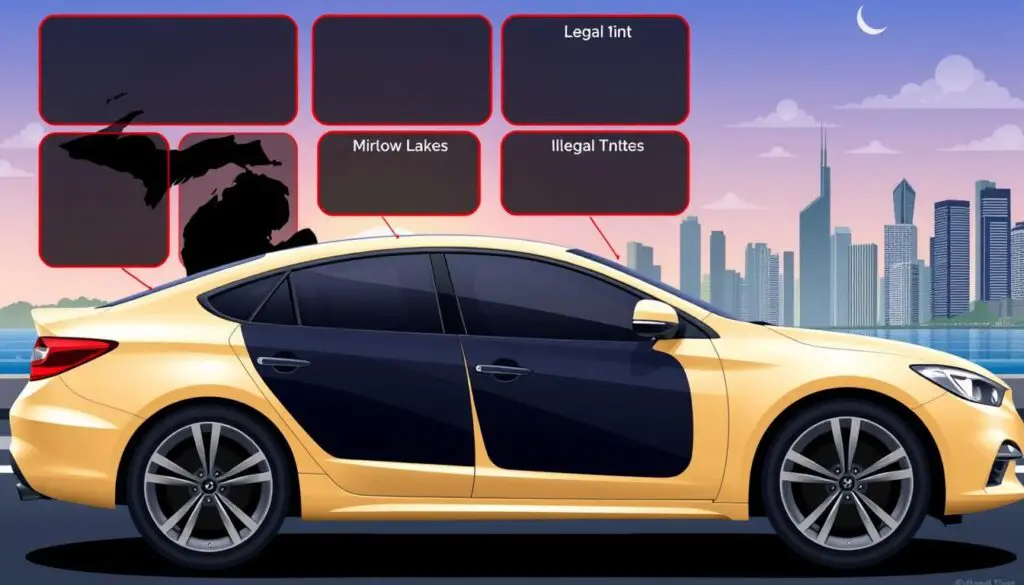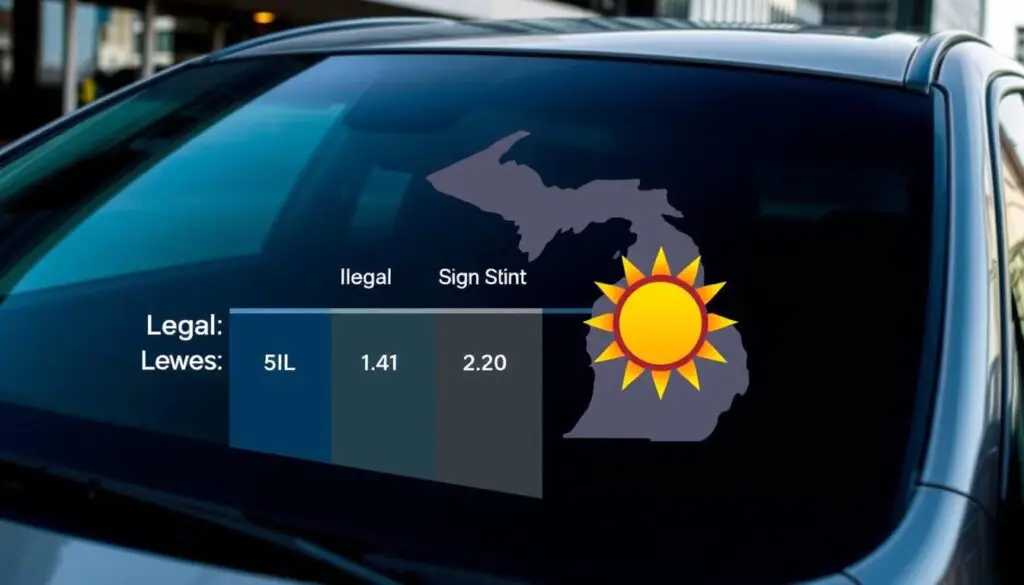If you live in Michigan, you might wonder about 25% window tint laws. Michigan has strict rules for tinting windows, depending on your vehicle and where the tint is. It’s key to know the specifics of Michigan’s tint laws.
Key Takeaways
- Michigan’s window tinting laws were enacted in 2000 and regulate tint darkness based on Visible Light Transmission (VLT) percentage.
- Legal tint limits vary for different vehicle types and window locations, with specific requirements for sedans, SUVs, vans, and commercial vehicles.
- The front windshield and front side windows have strict tint restrictions, while the back side windows and rear windshield may have more flexibility.
- Medical exemptions are available in Michigan with a doctor’s note, allowing for tinted windows due to health concerns.
- Penalties and enforcement of tint laws ensure compliance, with possible fines and other consequences for non-compliance.
Understanding Michigan Window Tint Regulations
In Michigan, the Visible Light Transmission (VLT) percentage is key for window tint rules. VLT shows how much light can go through tinted windows. Michigan’s tint laws started in 2000, making it a bit late compared to others.
Definition of VLT Percentage
The VLT percentage shows how dark a tint is. In Michigan, front side windows need to let in more than 35% of light. This is why it’s important to follow the 35% VLT rule.
History of Michigan Tint Laws
Michigan’s tint rules began in the early 2000s. It was a bit slower than some states. But now, tint laws are a big deal for drivers and car owners.
Basic Legal Requirements
Michigan’s tint laws say no reflective tint on back side windows. This means you need non-reflective tint there. Breaking these rules can cost you $50 to $150 for the first time. Later, fines can go up to $500 or more.
“Repeat offenses of tint violations in Michigan can lead to increased fines, longer periods of non-compliance penalties, and possible license suspension or vehicle impoundment, highlighting the need to address violations quickly.”
Is 25 Tint Legal in Michigan
In Michigan, the rules for window tint can be a bit confusing. The state doesn’t say how dark the tint can be for back windows and the rear windshield. But, the front windows can’t be darker than 35%.
The rules for a 25% VLT tint in Michigan depend on where it’s used. For cars, a 25% tint is okay for the back windows and rear windshield. But, it’s not allowed on the front windows because they need to let in more light.
For bigger vehicles like SUVs and vans, a 25% tint might be legal for the back windows. But, the front windows need to let in more than 35% of light.
| Vehicle Type | Legal Tint Darkness |
|---|---|
| Sedans and Passenger Cars | 35% VLT or higher on front side windows, any darkness on back side windows and rear windshield |
| SUVs and Vans | 35% VLT or higher on front side windows, any darkness on back side windows and rear windshield |
Michigan also has rules about how much tint can reflect light. There are medical exemptions and special cases too. Always check with a pro or local authorities before getting a tint. This ensures you follow the legal tint darkness and Michigan tint restrictions.

Legal Tint Limits for Different Vehicle Types
Michigan’s window tint laws are the same for all vehicles. This includes sedans, SUVs, and commercial vehicles. Everyone must follow the same rules to stay legal.
Sedans and Passenger Cars
In Michigan, sedans and other passenger cars can have non-reflective tint on the top 4 inches of the windshield. The back side windows and rear windshield can be tinted to any level, as long as it’s not reflective. But, the front side windows can only have a tint that reflects no more than 35%.
SUVs and Vans
The tint rules for SUVs and vans in Michigan are very similar to those for sedans. The windshield can have non-reflective tint on the top 4 inches. The rear and back side windows can be tinted to any darkness level. But, the front side windows can only reflect up to 35%.
Commercial Vehicles
Commercial vehicles in Michigan, like trucks and delivery vans, must follow the same tint rules as passenger cars. The windshield, front side windows, back side windows, and rear windshield all have the same limits as sedans and SUVs.
It’s very important for Michigan drivers to make sure their window tints follow the state’s vehicle-specific tint laws. This helps avoid fines and other penalties. Knowing about Michigan car tint limits and SUV window tinting rules ensures a safe and legal drive.
Windshield and Front Window Tinting Rules
In Michigan, the rules for tinting windshields and front windows are clear. You can have non-reflective tint on the top 4 inches of the windshield. This helps cut down glare and makes driving easier.
For the front side windows, Michigan has stricter rules. You can tint these windows, but only the top 4 inches. This ensures at least 35% of light can pass through, unlike the windshield.
The tint on front side windows can be up to 35% reflective. This reduces heat and glare without making the windows too dark. It keeps the driver and others on the road safe.

These rules apply to all vehicles in Michigan, including cars, SUVs, vans, and trucks. Following the state’s windshield tint regulations and front window tint limits is key. It helps avoid trouble with the police and keeps driving safe.
Back Windows and Rear Windshield Regulations
In Michigan, the rules for tinting back windows and the rear windshield are simple. You can tint these areas as dark as you like. Just make sure the reflection is no more than 35%.
Reflection Requirements
The laws in Michigan say the front and back side windows, including the rear windshield, can reflect up to 35%. This means your rear window tint can be very dark. But, it can’t reflect more than 35% overall.
Darkness Limitations
Michigan doesn’t set a specific Visible Light Transmission (VLT) percentage for back window regulations. But, the tint must meet the 35% reflectivity rule. This lets you have dark Michigan tint reflection laws on your rear windows. Just make sure the tint doesn’t reflect too much.
If your car’s rear window is tinted, you need dual side view mirrors. This helps with the reduced visibility.
Following these rules ensures your vehicle’s rear window tint is legal in Michigan. This keeps your car in line with the state’s tinting laws.
Medical Exemptions and Special Considerations
In Michigan, some medical conditions need darker window tints for safety. This is why there are Michigan tint exemptions. People with glaucoma, migraines, or skin problems that hurt from sunlight might get a special permit. This permit lets them use a medical window tint that’s darker than usual tint law exceptions.
To get a medical exemption, drivers need a doctor’s note or prescription. It must explain their condition and why they need a darker tint. With approval, they can legally have a tint that’s darker than the 35% Visible Light Transmission (VLT) limit. This helps block the sun’s glare.
Even with a medical exemption, drivers might get stopped by police. But, if they have the right papers, they won’t get a ticket for tinted windows. The exemption lets them have a tint that’s right for their health. This keeps them safe and comfortable while driving.
| Condition | Tint Exemption Allowed |
|---|---|
| Glaucoma | Darker tint on front side windows |
| Migraines | Darker tint on front side windows |
| Skin Ailments | Darker tint on front side windows |
It’s key for drivers with health issues to know about Michigan tint exemptions and medical window tint rules. By getting the right papers, they can make sure their cars are safe and legal for their needs.
Legal Requirements for Window Tint Installation
Window tinting in Michigan has strict rules. The state sets limits on tint levels and how it’s installed. This ensures your car looks good and is safe.
Certification Requirements
Michigan doesn’t require tint makers to get their products certified. The car owner must make sure the tint is legal. You don’t need a sticker to prove it’s okay.
But, police can check the tint level on your car. They make sure it follows the rules.
Professional Installation Guidelines
Michigan doesn’t need installers to be certified. But, it’s smart to use a professional tinting specialist. They know the Michigan tint installation laws well.
They can apply the film right. They also help with window film certification and the professional tinting process.
Choosing a trusted tinting pro makes your car look great. It also makes sure it follows Michigan’s rules. This way, you avoid trouble with the law.
Penalties and Enforcement of Tint Laws
In Michigan, illegal window tint is a big deal. Police can stop cars just for tint issues. First-time offenders get a “fix-it ticket” and a small fee.
But, if you get caught again, fines go up. And if you keep getting caught, it can hurt your driving record. This might raise your insurance and affect your license.
Michigan tint violations are not crimes, but they can cause big problems. State law lets police give tickets for tint that’s too dark or shiny. These window tint tickets can be small or big, based on the violation and your driving history.
| Violation Type | Typical Penalty |
|---|---|
| First Offense | Fix-it ticket with $25 processing fee |
| Subsequent Offenses | Fines up to $100, plus points on driving record |
| Repeated Violations | Increased fines, higher insurance rates, and possible license suspension |
Michigan’s tint laws have been around for 20 years. Even back then, there was good tint film available. So, police really enforce these laws to keep everyone safe.
Drivers should know the tint laws to avoid trouble. This way, they can drive safely and avoid fines.
Conclusion
Michigan’s window tint laws are complex. They set strict limits for the front windows and windshield. But, the rear windows have more freedom.
Knowing these legal tint options is key for car owners in Michigan. It helps avoid fines and keeps you safe.
It doesn’t matter if you drive a car, SUV, or van. You must know the Michigan vehicle code for tinting. Working with experts and staying updated ensures you get the most out of tinted windows.
In the end, Michigan’s tinting laws are about finding a balance. By following the rules, you can enjoy tinted windows safely and legally.
